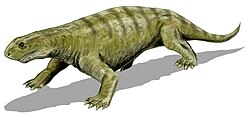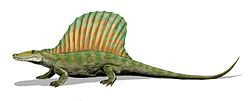| Shashajaia Temporal range: | |
|---|---|
 | |
| Diagram of CM 96529, a mandible of S. bermani | |
| Scientific classification | |
| Kingdom: | Animalia |
| Phylum: | Chordata |
| Clade: | Synapsida |
| Clade: | Sphenacodontia |
| Genus: | † Shashajaia Huttenlocker et al., 2021 |
| Species: | †S. bermani |
| Binomial name | |
| †Shashajaia bermani Huttenlocker et al., 2021 | |
Shashajaia is a genus of extinct non-mammalian synapsids from the late Carboniferous to Early Permian. It was one of the earliest members of the group, coming from the Gzhelian stage. [1] It lived in what is now the Halgaito Formation within the larger Cutler group located in the U.S state of Utah. According to a description study, this synapsid is known from well preserved dentary and jaw fragments. [1] Shashajaia shares many similarities to other sphenacodontids including, enlarged (canine-like) anterior dentary teeth, a dorsoventrally deep symphysis and low-crowned, subthecodont postcanines having festooned plicidentine. [1] The study also found that this genus is close to the evolutionary divergence of the Sphenacodontids and the Therapsids, from which mammalian synapsids (including humans) arose from. [1] Based on studies done on its teeth, Paleontologists found that as their prey became more terrestrial, synapsids like Shashajaia adapted to life on land and grew larger teeth to deal with larger herbivores in an evolutionary arms race. [1]






